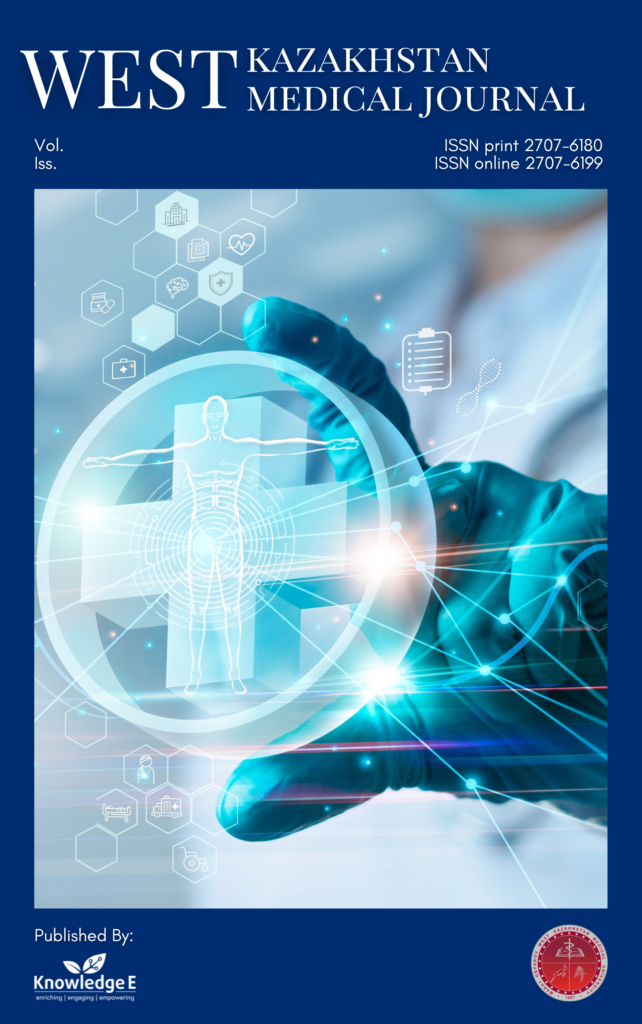
West Kazakhstan Medical Journal
ISSN: 2707-6180 (Print) 2707-6199 (Online)
Pioneering research advancing the frontiers of medical knowledge and healthcare practices.
The Influence of Movement Imitation Therapy on Neurological Outcomes in Children Who Have Experienced Adverse Perinatal Conditions
Published date: Dec 20 2024
Journal Title: West Kazakhstan Medical Journal
Issue title: West Kazakhstan Medical Journal: Volume 66 Issue 4
Pages: 331 - 342
Authors:
Abstract:
This study aimed to evaluate the effectiveness of early intervention (EI) for infants at high risk for cerebral palsy (CP), particularly in the context of their neurological development. The study was conducted at the Regional Perinatal Center in Aktobe, Kazakhstan, and included 69 preterm infants with adverse neonatal periods. The infants were divided into two groups: the first group (n=50) began EI at 42 weeks postmenstrual age, while the second group (n=19) started at 52 weeks. Both groups underwent general movements assessment (GMA) and motor activity monitoring using general movement optimality score (GMOS). Results showed that infants receiving EI earlier demonstrated significant improvements in movement quality and a reduced risk of adverse neurological outcomes compared to the control group. The findings highlight the importance of early detection and intervention, as well as the need for implementing early diagnostic programs for infants at risk.
Keywords: early intervention, cerebral palsy, general movements, neurological development, preterm infants
References:
[1] Patel RM. Short- and long-term outcomes for extremely preterm infants. Am J Perinatol. 2016;33(3):318-28, https://doi.org/10.1055/s-0035-1571202
[2] Valdez Sandoval P, Hernández Rosales P, Quiñones Hernández DG, Chavana Naranjo EA, García Navarro V. Intraventricular hemorrhage and posthemorrhagic hydrocephalus in preterm infants: diagnosis, classification, and treatment options. Childs Nerv Syst. 2019;35(6):917-927, https://doi.org/10.1007/s00381-019-04127-x
[3] McGowan EC, Vohr BR. Neurodevelopmental follow-up of preterm infants: what is new? Pediatric Clinics. 2019;66(2):509-523,
[4] Burnett AC, Cheong JLY, Doyle LW. Biological and social influences on the neurodevelopmental outcomes of preterm infants. Clin Perinatol. 2018;45(3):485-500, https://doi.org/10.1016/j.clp.2018.05.005
[5] Spittle AJ, Morgan C, Olsen JE, Novak I, Cheong JLY. Early diagnosis and treatment of cerebral palsy in children with a history of preterm birth. Clin Perinatol. 2018;45(3):409-420, https://doi.org/10.1016/j.clp.2018.05.011
[6] Palmer FB. Strategies for the early diagnosis of cerebral palsy. Journal of Pediatrics. 2004;145(2 SUPPL.):S8-S11, https://doi.org/10.1016/j.jpeds.2004.05.016
[7] Stanojevic M, Perlman JM, Andonotopo W, Kurjak A. From fetal to neonatal behavioral status. Ultrasound Review of Obstetrics and Gynecology. 2004;4(1):59-71, https://doi.org/10.1080/14722240410001713939
[8] Einspieler C, Prechtl HFR. Prechtl’s assessment of general movements: A diagnostic tool for the functional assessment of the young nervous system. Mental Retardation and Developmental Disabilities Research Reviews. 2005;11(1):61-67, https://doi.org/10.1002/mrdd.20051
[9] Bosanquet M, Copeland L, Ware R, Boyd R. A systematic review of tests to predict cerebral palsy in young children. Developmental Medicine and Child Neurology. 2013;55(5):418-426, https://doi.org/10.1111/dmcn.12140
[10] Einspieler C, Marschik PB, Bos AF, Ferrari F, Cioni G. Heinz F. R. Prechtl, 1927-2014 crossing the borders. Developmental Psychobiology. 2014;56(7):1609-1611, https://doi.org/10.1002/dev.21255
[11] Einspieler C, Sigafoos J, Bartl-Pokorny KD, Landa R, Marschik PB, Bölte S. Highlighting the first 5 months of life: General movements in infants later diagnosed with autism spectrum disorder or Rett syndrome. Research in Autism Spectrum Disorders. 2014;8(3):286-291, https://doi.org/10.1016/j.rasd.2013.12.013
[12] Novak I, Morgan C, Adde L, Blackman J, Boyd RN, Brunstrom-Hernandez J, et al. Early, accurate diagnosis and early intervention in cerebral palsy: Advances in diagnosis and treatment. JAMA Pediatrics. 2017;171(9):897-907, https://doi.org/10.1001/jamapediatrics.2017.1689
[13] Ferrari F, Cioni G, Prechtl H. Qualitative changes of general movements in preterm infants with brain lesions. Early human development. 1990;23(3):193-231,
[14] Hadders-Algra M. Early diagnostics and early intervention in neurodevelopmental disorders—age-dependent challenges and opportunities. Journal of Clinical Medicine. 2021;10(4):1-24, https://doi.org/10.3390/jcm10040861
[15] Kniaziew-Gomoluch K, Szopa A, Łosień T, Siwiec J, Kidoń Z, Domagalska-Szopa M. Reliability and Repeatability of a Postural Control Test for Preterm Infants. International Journal of Environmental Research and Public Health. 2023;20(3), https://doi.org/10.3390/ijerph20031868
[16] El-Dib M, Massaro AN, Glass P, Aly H. Neurodevelopmental assessment of the newborn: An opportunity for prediction of outcome. Brain and Development. 2011;33(2):95-105, https://doi.org/10.1016/j.braindev.2010.04.004
[17] Morgan C, Novak I, Dale RC, Guzzetta A, Badawi N. GAME (Goals - Activity - Motor Enrichment): Protocol of a single blind randomised controlled trial of motor training, parent education and environmental enrichment for infants at high risk of cerebral palsy. BMC Neurology. 2014;14(1), https://doi.org/10.1186/s12883-014-0203-2
[18] Crowle C, Jackman M, Morgan C. The general movements motor optimality score in high-risk infants: A systematic scoping review. Pediatric Physical Therapy. 2023;35(1):2-26, https://doi.org/10.1097/PEP.0000000000000969
[19] Prechtl HFR. Spontaneous motor activity as a diagnostic tool: Functional assessment of the young nervous system. A Scientific Illustration of Prechtl’s Method: GM Trust; 1997.
[20] Prechtl HFR. General movement assessment as a method of developmental neurology: New paradigms and their consequences: The 1999 Ronnie MacKeith Lecture. Developmental Medicine and Child Neurology. 2001;43(12):836-842, https://doi.org/10.1111/j.1469-8749.2001.tb00173.x
[21] Einspieler C, Marschik PB, Pansy J, Scheuchenegger A, Krieber M, Yang H, et al. The general movement optimality score: A detailed assessment of general movements during preterm and term age. Developmental Medicine and Child Neurology. 2016;58(4):361-368, https://doi.org/10.1111/dmcn.12923
[22] Einspieler C, Peharz R, Marschik PB. Fidgety movements–tiny in appearance, but huge in impact. Jornal de Pediatria. 2016;92:64-70,
[23] Einspieler C, Bos AF, Spittle AJ, Bertoncelli N, Burger M, Peyton C, et al. The general movement optimality score-revised (GMOS-R) with socioeconomically stratified percentile ranks. Journal of Clinical Medicine. 2024;13(8):2260,
[24] Soloveichick M, Marschik PB, Gover A, Molad M, Kessel I, Einspieler C. Movement imitation therapy for preterm babies (MIT-PB): A novel approach to improve the neurodevelopmental outcome of infants at high-risk for cerebral palsy. J Dev Phys Disabil. 2020;32(4):587-598, https://doi.org/10.1007/s10882-019-09707-y
[25] Marschik PB, Kwong AKL, Silva N, Olsen JE, Schulte-Rüther M, Bölte S, et al. Mobile solutions for clinical surveillance and evaluation in infancy—general movement apps. Journal of Clinical Medicine. 2023;12(10), https://doi.org/10.3390/jcm12103576